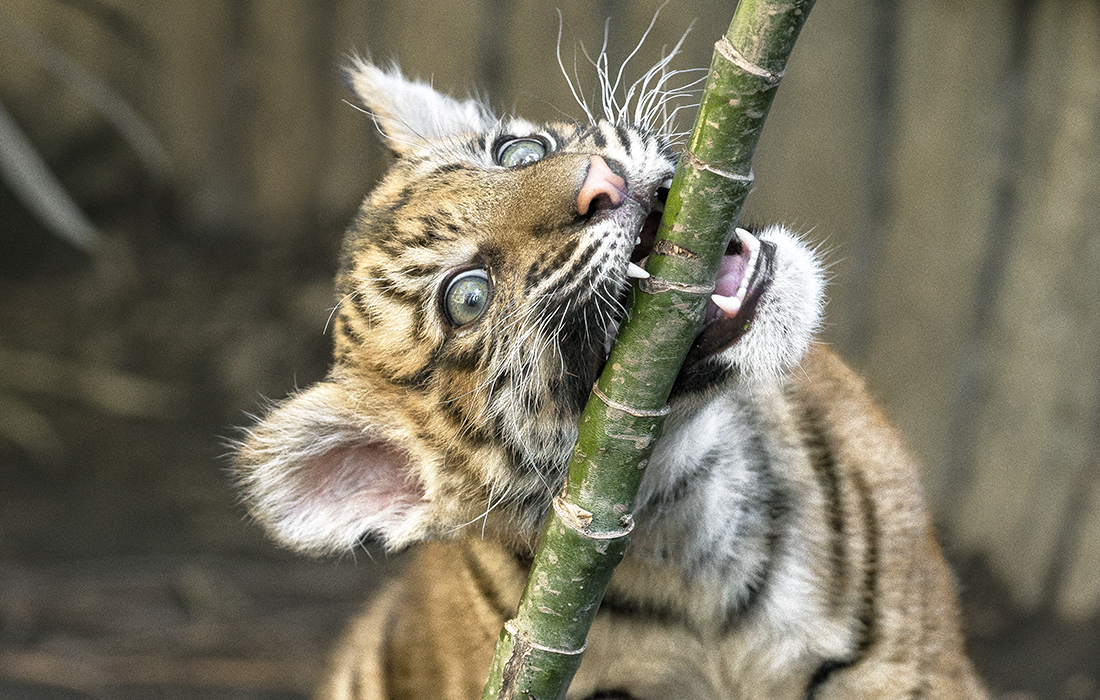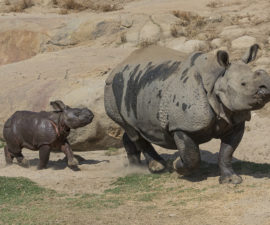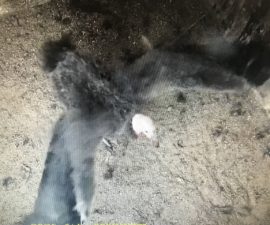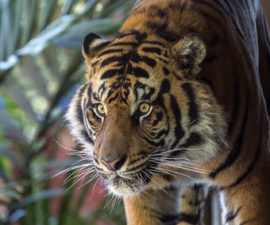BY Peggy Scott
Photography by Ken Bohn
Videography by Lee Rieber
It takes a village to raise a child, and recently it took a department—several, actually—to save and raise a tiger cub. When Joanne, a first-time Sumatran tiger Panthera tigris sumatrae mother at the Safari Park, had trouble caring for her newborn singleton cub, a combination of veterinary expertise, teamwork, and a little good luck all joined forces to cure his ailments and bring him roaring back to recovery. Many people poured their heart into getting the little tiger back on his feet, and the dedication it took to save him is reflected in his name, Suka, which means “loved” in the Malay language.
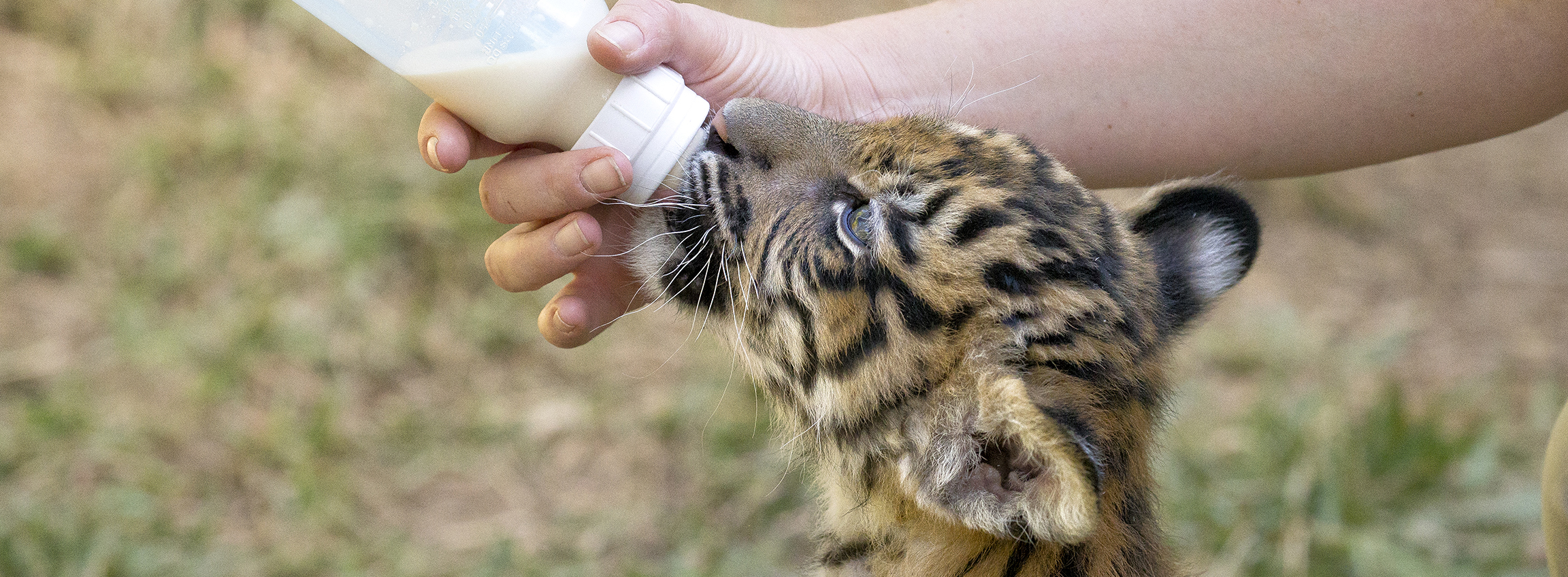
 The number of pounds of meat a tiger can consume at one “sitting.”
The number of pounds of meat a tiger can consume at one “sitting.”
A “Ruff” Start
Born in the wee hours of September 14, 2015, all appeared to be well with the cub until four days later, when Joanne stopped looking after him—something not uncommon with single tiger births, explains Lissa McCaffree, a lead animal keeper at the Park. “It happens with singles sometimes, but she was attentive at first,” Lissa says. Joanne’s lack of involvement and Suka’s resulting weight loss led the Park’s animal care team to make the difficult decision to hand-rear the cub; something the Park hadn’t had to do for more than three decades. Initially, he adjusted to the change. “We were happy with his progress, as he took to the bottle and started nursing right away,” Lissa says. At the Safari Park’s Ione and Paul Harter Animal Care Center, Suka was bottle-fed seven times a day—with a formula especially for carnivores, made from goats’ milk and easy for tigers to digest. But keepers sensed something was wrong, as the little tiger still failed to thrive.
Suka was moved from his den at the Tull Family Tiger Trail to the Animal Care Center (ACC), where he was given a checkup. Tests revealed an electrolyte imbalance, which zoological medicine resident Katie Delk, DVM, attributes to a problem with the little tiger’s physiology. “An anatomical abnormality in Suka caused him to develop a serious urinary tract infection,” Katie says. “The infection was so severe that it traveled from his bladder to his kidneys, where the infection prevented the regulation of his electrolytes.” Subcutaneous IV fluids and antibiotics were administered—and not a minute too soon, Katie notes. “The imbalance was life-threatening,” she says. “Without quick intervention by the veterinary staff, he definitely would not have survived. We were able to hospitalize him, and serial monitoring of blood work and ultrasound imaging of his urinary tract helped us monitor his progression.” Suka was only one week old. While she couldn’t find such a diagnosis in the veterinary literature she consulted, Katie says this malady affects babies of another kind. “This condition is well-documented in human children, so that literature was very helpful as we created his treatment plan,” she says.
The young cub, despite his ailments, proved to be an agreeable patient. “It only took giving him his bottle for him to tolerate the treatment,” Lissa says. “He was so patient and good-natured.”
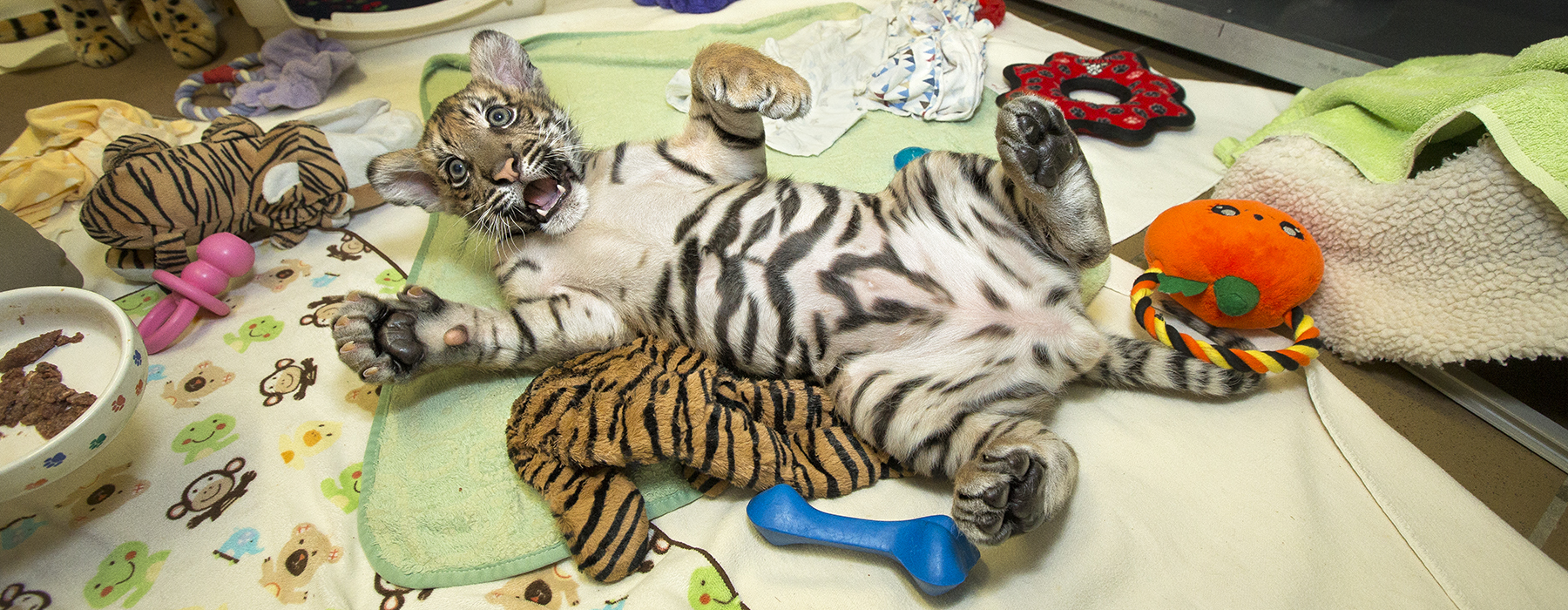
 The number of tiger subspecies still in existence.
The number of tiger subspecies still in existence.
Tiger Tag-teaming
Suka’s case was a serious one, and couldn’t be cured overnight. The treatment took several months, and, as Lissa points out, was quite the group effort. “He was under intensive, 24-hour care for over a month, and so many people pitched in to help,” she says. “The vet staff and Suka’s keepers worked so hard, and keepers from other Park areas helped cover our regular shifts so we could attend to him. The Zoo’s neonatal keepers came to help out. It was so emotional—up one minute and down the next—it took a toll on everyone.”
And all that hard work paid off. By early December, Suka was off all treatment, the urinary tract infection was resolved, and his kidneys regained normal function. The cub was growing steadily, weighing a healthy 18 1/2 pounds, and developing normally. His personality emerged, and he learned to make tiger vocalizations, such as meows, grunts, and “chuffing,” a vocalization tigers make as a way to express excitement, or as a greeting. Katie was cautiously optimistic. “He was, at that point, still too small to correct his anatomical abnormality, so we are waiting until he is almost full grown, and then will schedule a procedure to try and correct it,” she says. “But he’s growing well, eating meat and taking fewer bottles.”
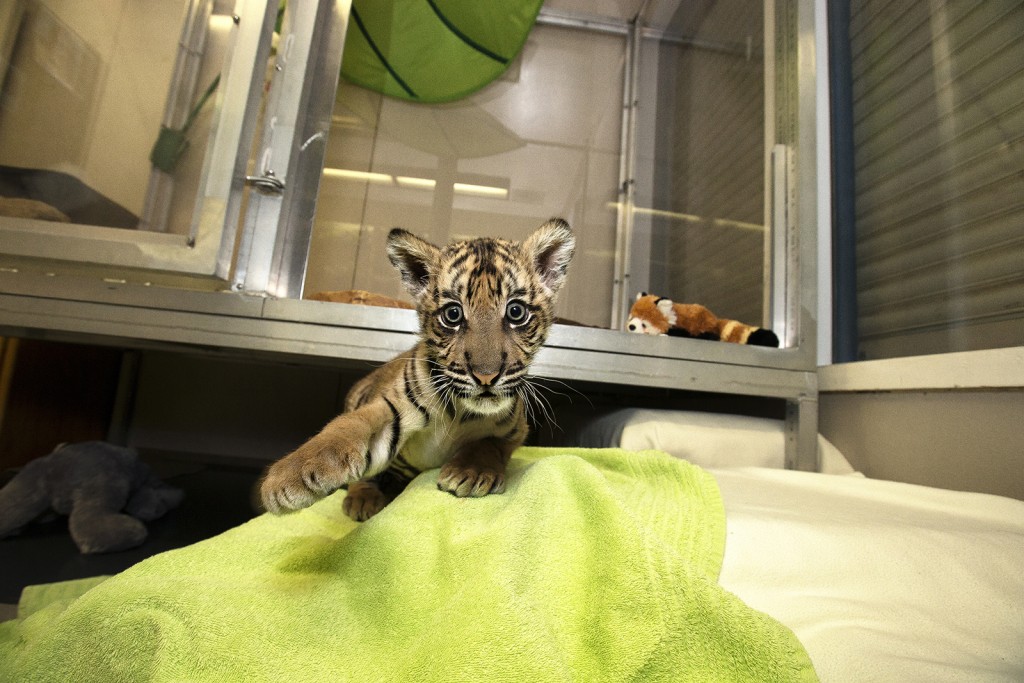
BATTING PRACTICE
To a tiger cub, everything is a potential plaything–even a photographer’s camera!
The now rambunctious cub bonded quickly with his keepers, and became accustomed to being the center of attention. “We would hear him cry from his room at the ACC, and we had to learn to judge whether it was pain or distress, or if he just wanted attention,” Lissa says. “We have a camera on him and a monitor, so we can see him from the other area.”
When he’s not trying to charm his keepers into playing with him, Suka entertains himself by tussling with his plush shark and cheetah. “He also loves to soak in his tub. We call it ‘hot tub time,’” Lissa says, adding that the cub finds this activity so relaxing that he has been known to poop in his tub.
Suka also became comfortable around his adoring public, who came to watch him on exhibit in the ACC. Keepers made sure he had private spaces, too, in case he wanted a little “me time.” His next milestone came in the form of visits from keepers at Tiger Trail, which the cub would eventually call home. “We went at his pace, making sure he was comfortable,” Lissa says, noting that his impending departure from the ACC, while sad for them, would be an achievement and cause for celebration. “We look forward to the ‘graduation’ of the animals we care for here,” she explains. “It means they’re well. Our end goal is them moving on to their new life.”
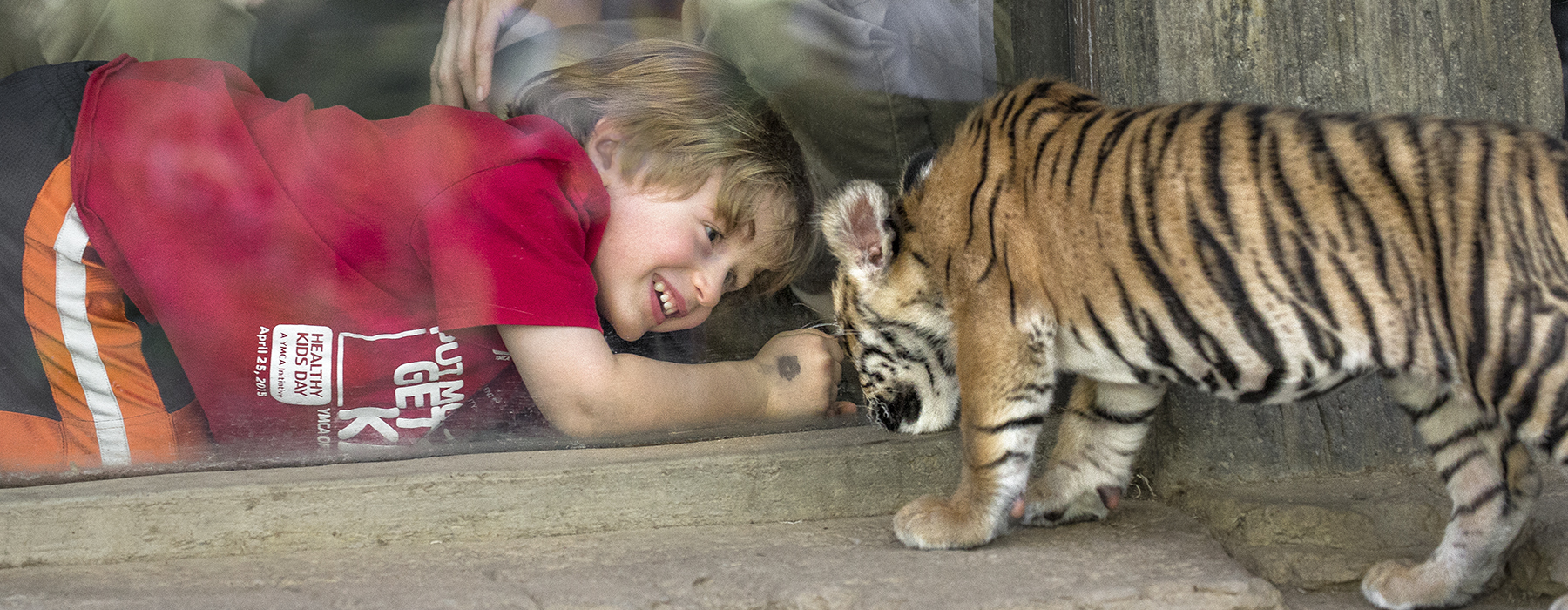
 The percentage of their historical range that tigers have lost in the past 100 years.
The percentage of their historical range that tigers have lost in the past 100 years.
Happy Trail(s)
By mid-December, Suka’s keepers were taking him on field trips to Tiger Trail, to familiarize the cub with his future home. The confident young cat took to the exhibit like, well, a tiger to water. Once he was outdoors, the cub soon began exhibiting his natural tiger behaviors, stalking, pouncing, trying to grab onto things, and crouching behind foliage—even sampling a few items before racing off again. He progressed quickly, and then “graduation day” came, with Suka moving to his new accommodations full time. Guests can see him daily from 9 a.m. to 1:30 p.m. in Yard A (on the western end of Sambutan Longhouse), and his out-of-town fans can tune into the Park’s Tiger Cam to watch him on his new adventure.
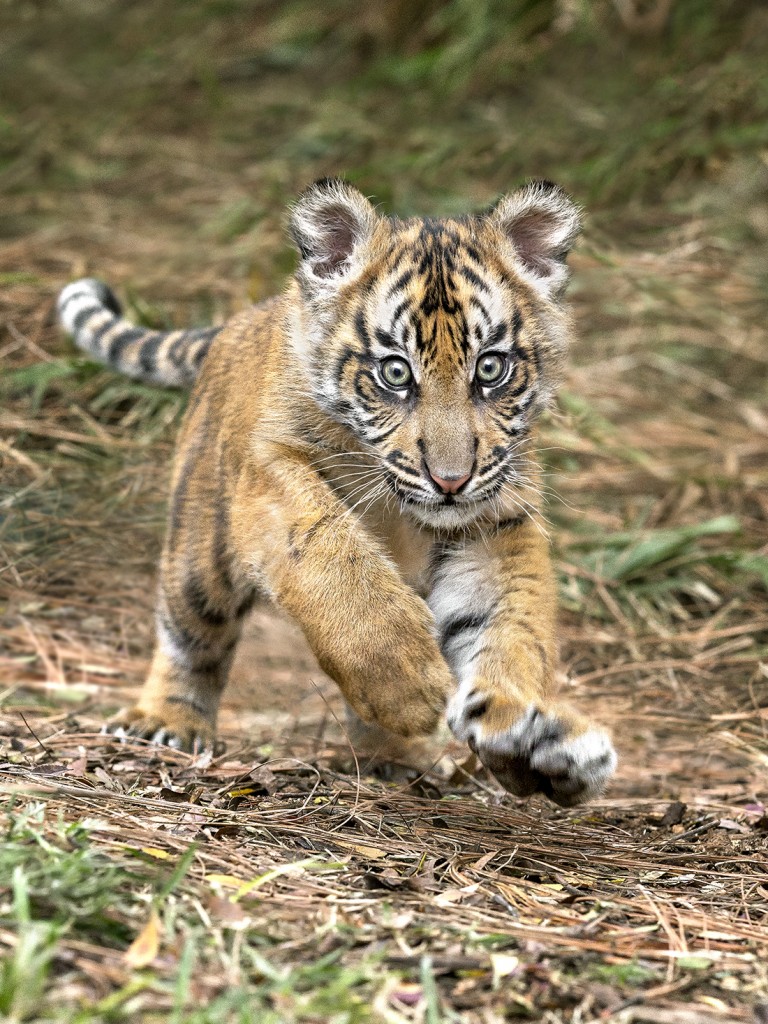
EYE OF THE TIGER
Suka the Sumatran tiger cub has the world by the tail.
While the arrival of any baby animal is a cause for celebration, the birth of this cub, the 26th Sumatran tiger born at the Park, is particularly significant. “Since he is the first offspring of Joanne and Teddy, his genetics are valuable to the population,” Lissa says. The Safari Park is now home to 7 of these rare animals, and there are fewer than 350 Sumatran tigers in the wild, with that number continuing to decline. Scientists estimate that this species could be extinct in its native Sumatra by 2020, unless measures are taken to protect and preserve it.
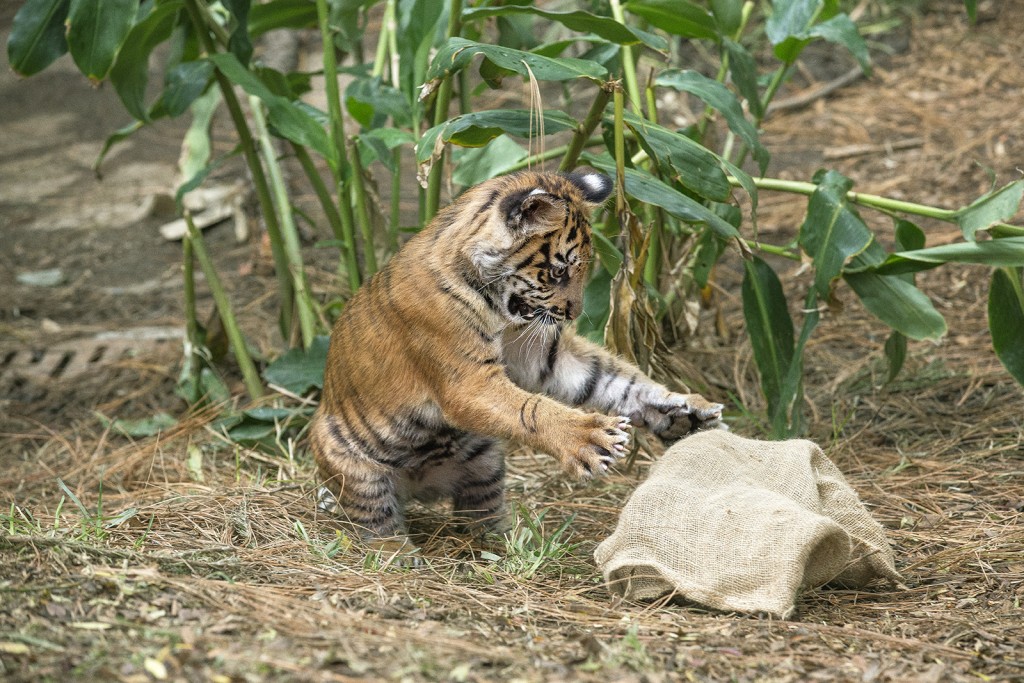
GRAB BAG
In Tiger Trail, Suka wasted no time doing what young cats do best: play!
All tiger species face many challenges in the wild, from loss of habitat to conflicts with humans, but the biggest threat continues to be poaching. Tigers are killed by poachers who illegally sell tiger body parts, mostly for folk remedies. People can help protect wild tigers by by refusing to purchase items made from endangered wildlife, and by avoiding products made with non-sustainable palm oil, an industry that harms tiger habitat. Saving tigers not only protects this majestic animal for future generations, it also helps with the bigger conservation picture, notes Randy Rieches, Henshaw curator of mammals at the Park. “Saving tigers is important, as they are a very prominent, iconic species that helps to save other species in their habitat,” Randy explains. “If we cannot save tigers, how can we hope to save other endangered species that are less well-known?” And Suka, the little tiger cub, is certainly doing his part to raise awareness about sharing the “love” of conservation.

